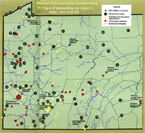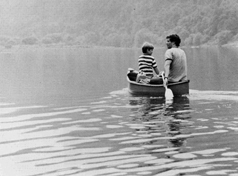|
Conserve |
|
| Conserve 75th Anniversary Commemorative Issue |
| 1930s - 40s |
| 1950s |
| 1960s |
| 1970s |
| 1980s |
| 1990s |
| 2000s |
| Fall 2007 Home |
| Past Issues |

An Interview With John Oliver

John Oliver served the longest term of any Conservancy president, spending
more than 17 years guiding this organization. Prior to joining the Conservancy,
Mr. Oliver served In the U.S. Navy where he received a purple heart
during his tour in Vietnam. In 1996, he was asked by then Pennsylvania
Governor Tom Ridge to head the Pennsylvania Department of Conservation
and Natural Resources.
Below, Mr. Oliver talks about two of the projects he guided during his years as president of WPC and about the concept of conservation in the late 1970s and 80s.
CONSERVE: What was involved with the Hickory Creek Wilderness Area: (10,000 acres with 90 owners)?
JOHN OLIVER: An incredible amount of planning was involved prior to the establishment of the Hickory Creek Wilderness Area in the Allegheny National Forest (ANF). The major issue was and is on any proposal that relates to wilderness in a national forest, ownership of the gas and mineral rights. In order for the Hickory Creek Wilderness Area to go forward, we had to purchase the gas and mineral rights and convey it to the federal government.
The other challenge was political. And fortunately in this case we had a congressman in that district, Bill Clinger, who along with Senator John Heinz and Conservancy staff, were able to convince decision makers in the region that creating a wilderness area would be good for the ANF. There were no wilderness areas in Pennsylvania prior to that, nor any eastern national forests for that matter. We had to convince the U.S. Forest Service to support this as well. To say it best, there was a lot of time spent in Washington on this issue.
CONSERVE: Cherry Run is the largest land acquisition in WPC history. How did those pieces come together?
JOHN OLIVER: It was really just once piece. Cherry Run was owned by a lumber company, and we bought the company whose only asset was the 13,000 acres. We liquidated the company and obtained the land and eventually conveyed it to the Pennsylvania Game Commission.
CONSERVE: What was the public perception of “conservation” in the late 1970’s? How have you seen public perception and opinion about conservation change over time?
JOHN OLIVER: In the 1970’s, a political rebirth of conservation took place. Major legislation came forth during the Nixon administration, including the Clean Air Act, the Clean Water Act and the National Environmental Policy Act. Pennsylvania had also passed two major acts that provided funds to acquire land for state parks and state forests. Under Josh Whetzel’s leadership, the Conservancy was able to make the most of these opportunities by serving as agents for many large scale acquisitions. Those were very exciting times.
CONSERVE: Do you think things are swinging back in that direction today?
JOHN OLIVER: Not on such a grand scale. I think conservation is more regional and local than before. It is not uncommon for opportunities to protect property in 100 acre or less increments. Few organizations have the financial resources to deal with working forests and large landscapes that are so critical for wildlife and outdoor recreation. The Conservancy is a major exception.
CONSERVE: During your tenure, the Clarion River Project was formed and grew (1982 – 4,800 acres protected). By 1990, total of 7,700 acres were protected. How did that project begin? What was involved in moving that project forward? What were the challenges in bringing a “dead river” back to life?
JOHN OLIVER: A Conservancy board member – Roger Latham, a former Pennsylvania Game Commission biologist and prominent outdoor writer for the Pittsburgh Press discovered the Clarion River project. He encouraged the Conservancy’s board and staff to take a look at the Clarion River, which at that time was known as a dead river because of all the pollution from paper mills. Sure enough, we went up there and found that indeed it was coming back to life. We focused on the 40-mile stretch between Ridgway and Clarion.
CONSERVE: What were the challenges in that project generally?
JOHN OLIVER: There were public land holdings along the north and south shores of the Clarion—the Allegheny National Forest lands, game lands the state parks and forests. So we tried to fill in the gaps in those existing public lands. There were the normal challenges of buying land for recreational purposes.
CONSERVE: What about the paper companies?
JOHN OLIVER: We were in touch with them as well and established a good working relationship. They were under the gun to clean up their discharges, and they did.
CONSERVE: It must be satisfying to see the Rails to Trails program nearly completed. What was it like in the 1970’s and 1980’s to get that project off the ground?
JOHN OLIVER: This was a project that began when the Chessie System railroad company approached us and said that they planned to abandon their Western Maryland right-of-way along the Youghiogheny and Casselman Rivers in PA, and asked if we might we be interested. What appealed to us was the benefit of having an uninterrupted level graded trail going for miles and miles along these rivers. We concentrated primarily on the 25 miles within Ohiopyle State Park, from Dunbar in Fayette County to Confluence in Somerset County.
CONSERVE: How difficult was it to explain the vision of bike trails?
JOHN OLIVER: We envisioned multiple uses for the trail, not just for bikers and hikers. For the park itself, the trail was advantageous for people who wanted to go fishing along the river, or for hunters who wanted to go back into the deepest parts of the park and game lands. Back then, biking wasn’t as popular as it is today. But the momentum grew, and the rest is history.
CONSERVE: During your tenure, WPC expanded its “science” focus. How did that evolve?
JOHN OLIVER: We always had a strong science-based approach for all of our work, going back to the days of Dr. Otto Jennings and Dr. M. Graham Netting, who were powerful personalities during the Conservancy’s early years. This science approach became more evident when Paul Wiegman authored a book on Natural Areas of Western Pennsylvania, in which he identified our special landscapes of concern. All three became strong advocates of protecting smaller, more biologically significant natural areas.
CONSERVE: In 1983, WPC reached a milestone of 10,000 members, and growth continued after that….how did membership grow during this period?
JOHN OLIVER: Again, going back to the 70’s, there was tremendous excitement and enthusiasm for land and water conservation, and we capitalized on that by an aggressive membership campaign. We had a wonderful membership team led by Bill Randour who were very creative and effective in signing up new supporters.
CONSERVE: Please talk about the growth of Fallingwater during your tenure. (In 1980 the Visitor’s Pavilion was built; the 1988 PBS national broadcast of the “House on the Waterfall”)
JOHN OLIVER: We were very fortunate that Edgar Kaufman jr. became personally involved, because he knew what his parents wanted Fallingwater to be. He was very open to ideas and saw the potential for membership as well as the importance of using it for educational purposes. He worked closely with Tom Schmidt and Lynda Waggoner and together they made a lot of good things happen.
CONSERVE: What was it like to spend time with him?
JOHN OLIVER: Even though I have no background in art or architecture, we found common ground in Bear Run and the importance of this watershed to Fallingwater. Edgar was extremely articulate when it came to explaining the reason for Fallingwater, and spoke with a great deal of authority. I believe his voice is still being used to welcome visitors to Fallingwater.
CONSERVE: What are the greatest strengths that WPC brings to the western Pennsylvania region today?
JOHN OLIVER: It is an organization that has a wonderful history and tradition of land and water conservation in western Pennsylvania, as well as a proven track record of outstanding accomplishments. Its strength is a philosophy of developing reasonable and balanced positions regarding conservation and of working effectively with leaders in business and government.
CONSERVE: How has the role of land and water conservation organizations changed over the past 20-30 years?
JOHN OLIVER: In the 70’s and up to the mid 1980’s, conservation was top-down action. Today it is just the opposite. Growing Greener I and Growing Greener II were successful because the idea emanated from the local governments, small organizations, agencies and business groups—from the bottom up, so to speak. It’s grassroots conservation. Look at the incredible expansion of local watersheds dealing with acid mine drainage for example. It has been proven that open space is important to the quality of life and to economic development in cities and towns through Pennsylvania. And that’s why those successful programs are still in vogue today.
CONSERVE: Looking back on WPC’s growth over 75 years, what projects do you consider most noteworthy and significant for western Pennsylvania?
JOHN OLIVER: I can’t single out one project…they all have their special qualities and have made very significant contributions to land and water conservation in the regions where they are located.
CONSERVE: What do you see in the future for organizations like WPC?
JOHN OLIVER: I think there is always a role for land trusts and conservancies and for the WPC in particular. There is always a demand to protect by acquisition the very special landscapes in Pennsylvania.
CONSERVE: Do you feel a sense of urgency right now?
JOHN OLIVER: On a local level, yes, there is, albeit it’s more challenging. Sprawl is still the number one environmental problem in Pennsylvania, as identified by the Pennsylvania 21st Century Environment Conservation report in 1997 and by the Brookings Institute more recently. Back in the mid 1980’s, 100 acres of Pennsylvania land was being converted to strip malls and other uses every day. Now it is 350 acres per day. Again, there will always be work for the western Pennsylvania Conservancy and other like minded organizations.
